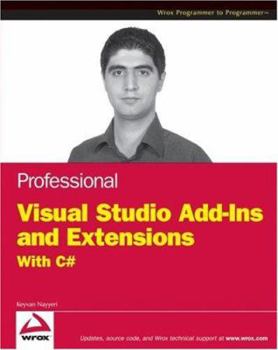Professional Visual Studio Extensibility
Visual Studio is a development IDE created by Microsoft to enable easier development for Microsoft programming languages as well as development technologies. It has been the most popular IDE for... This description may be from another edition of this product.
Format:Paperback
Language:English
ISBN:0470230843
ISBN13:9780470230848
Release Date:March 2008
Publisher:Wrox Press
Length:520 Pages
Weight:3.00 lbs.
Dimensions:1.1" x 7.4" x 9.1"
Customer Reviews
2 ratings
Good Book
Published by Thriftbooks.com User , 15 years ago
Keyvan Nayyeri explores each of the areas of VS Extensibility. He breaks the book up into logical sections, first illustrating the API that Visual Studio uses to represent the user interface. If you have never looked at the API for Visual Studio before, it's not user friendly, so it was good that he provided a brief description of the properties and methods for the various objects, followed by a few examples using those objects to perform certain tasks. I thought some of the most useful content of the book features discussions on showing custom windows forms, and creating custom option windows using user controls (to display in the Tools > Options dialog), and creating custom debugger type proxies and visualizers. That's definitely not all the book focuses on; the subject matter also ranges in the areas of working with solutions, projects, code files, the text editor, command bars, custom windows, deployment, testing, unit testing and more. <br /> <br />The book covers other topics related to extensibility. Keyvan covers the Visual Studio hive and how it can be used when developing VS extensions. It also covers Domain Specific Language tools (which I was appreciative for because I didn't fully understand what DSL was supposed to be) by creating a sample language. Code Snippets and Templates are another feature I look forward to implement in one of my applications, because it will be very useful and helpful to my fellow coworkers. And, one of the more interesting topics for VS Packages, <br />Keyvan works with a consistent motion throughout the book. When he explained the API, he started out explaining each object related to the chapter, then ended the chapter with some sample code. When getting into the other subjects like extending the debugger or macros, Keyvan discusses each subject and mixes in screenshots and code of what each feature looks like as he goes. Only in a couple of chapters does he primarily show the screenshots of how the utility or feature gets setup. <br /> <br />The other point about the book is how he attempt to explain the intricate details about the code that Visual Studio generates, regarding the Connect.cs and .AddIn files generated by the template. This is important because even though the code is generated for you. Again, it's not always clear what the code files are for and it's good to get an overview of these files from the book, and their purpose. <br /> <br />This book help whet my appetite for developing extensions, and I hope to develop one that is functional. The one caveat to this book is that it left me wanting to know more about extensibility, and I thought a few topics were cut short from what they could have been. I agree no book is perfect and will explain every subject to the readers desire, but I felt that a few more examples, or a larger example in an appendix would have been a benefit to the readers.
A good introduction.
Published by Thriftbooks.com User , 15 years ago
This is one of those difficult books to review because it attempts to cover a huge topic. Overall it provides a good overview of Visual Studio extensibility but if you want to really use it you're going to have to dive into the MSDN documentation and browse the source on CodePlex (Iron Python and Iron Python Studio are a must). Some topics, such as DSLs and MSBuild have other books dedicated to them. Unfortunately, due to the depth of the topic, a lot of the chapters are simple introductions and are only useful for highlighting a feature and what can be done with it. This isn't a bad thing, although I think these chapters could have been shortened and merged, and other topics added for completeness (such as language services). Overall, the book is well written with few errors, although chapter 11 (Tools Options Page) seems to have missed the editors pen and the code is incorrect (and/or not explained properly). The chapters on extending the debugger (17), code snippets (19) and templates (20) are particularly useful and make the book a worthwhile read.





